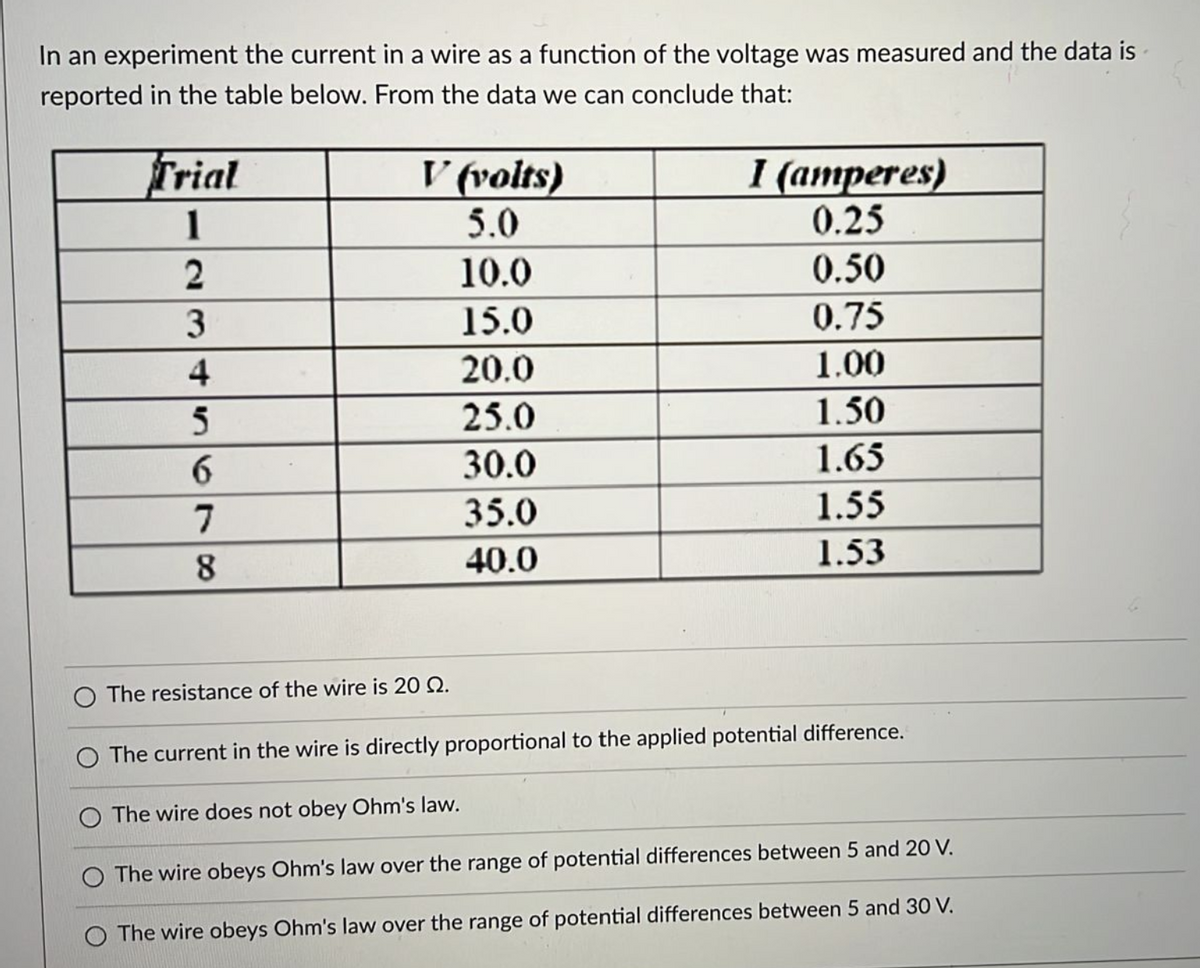In an experiment the current in a wire as a function of the voltage was measured and the data is reported in the table below. From the data we can conclude that: Frial V (volts) (атреres) 0.25 1 5.0 10.0 0.50 15.0 0.75 4 20.0 1.00 5 25.0 1.50 30.0 1.65 35.0 1.55 8. 40.0 1.53 O The resistance of the wire is 20 Q. The current in the wire is directly proportional to the applied potential difference. The wire does not obey Ohm's law. The wire obeys Ohm's law over the range of potential differences between 5 and 20 V. O The wire obeys Ohm's law over the range of potential differences between 5 and 3 V.
In an experiment the current in a wire as a function of the voltage was measured and the data is reported in the table below. From the data we can conclude that: Frial V (volts) (атреres) 0.25 1 5.0 10.0 0.50 15.0 0.75 4 20.0 1.00 5 25.0 1.50 30.0 1.65 35.0 1.55 8. 40.0 1.53 O The resistance of the wire is 20 Q. The current in the wire is directly proportional to the applied potential difference. The wire does not obey Ohm's law. The wire obeys Ohm's law over the range of potential differences between 5 and 20 V. O The wire obeys Ohm's law over the range of potential differences between 5 and 3 V.
Principles of Physics: A Calculus-Based Text
5th Edition
ISBN:9781133104261
Author:Raymond A. Serway, John W. Jewett
Publisher:Raymond A. Serway, John W. Jewett
Chapter21: Current And Direct Current Circuits
Section: Chapter Questions
Problem 13P: While taking photographs in Death Valley on a day when the temperature is 58.0C, Bill Hiker finds...
Related questions
Question

Transcribed Image Text:In an experiment the current in a wire as a function of the voltage was measured and the data is
reported in the table below. From the data we can conclude that:
Frial
V (volts)
(атреres)
0.25
1
5.0
10.0
0.50
15.0
0.75
4
20.0
1.00
5
25.0
1.50
30.0
1.65
35.0
1.55
8.
40.0
1.53
O The resistance of the wire is 20 Q.
The current in the wire is directly proportional to the applied potential difference.
The wire does not obey Ohm's law.
The wire obeys Ohm's law over the range of potential differences between 5 and 20 V.
O The wire obeys Ohm's law over the range of potential differences between 5 and 3 V.
Expert Solution
This question has been solved!
Explore an expertly crafted, step-by-step solution for a thorough understanding of key concepts.
Step by step
Solved in 2 steps with 2 images

Knowledge Booster
Learn more about
Need a deep-dive on the concept behind this application? Look no further. Learn more about this topic, physics and related others by exploring similar questions and additional content below.Recommended textbooks for you

Principles of Physics: A Calculus-Based Text
Physics
ISBN:
9781133104261
Author:
Raymond A. Serway, John W. Jewett
Publisher:
Cengage Learning


College Physics
Physics
ISBN:
9781938168000
Author:
Paul Peter Urone, Roger Hinrichs
Publisher:
OpenStax College

Principles of Physics: A Calculus-Based Text
Physics
ISBN:
9781133104261
Author:
Raymond A. Serway, John W. Jewett
Publisher:
Cengage Learning


College Physics
Physics
ISBN:
9781938168000
Author:
Paul Peter Urone, Roger Hinrichs
Publisher:
OpenStax College

Physics for Scientists and Engineers, Technology …
Physics
ISBN:
9781305116399
Author:
Raymond A. Serway, John W. Jewett
Publisher:
Cengage Learning

Physics for Scientists and Engineers: Foundations…
Physics
ISBN:
9781133939146
Author:
Katz, Debora M.
Publisher:
Cengage Learning